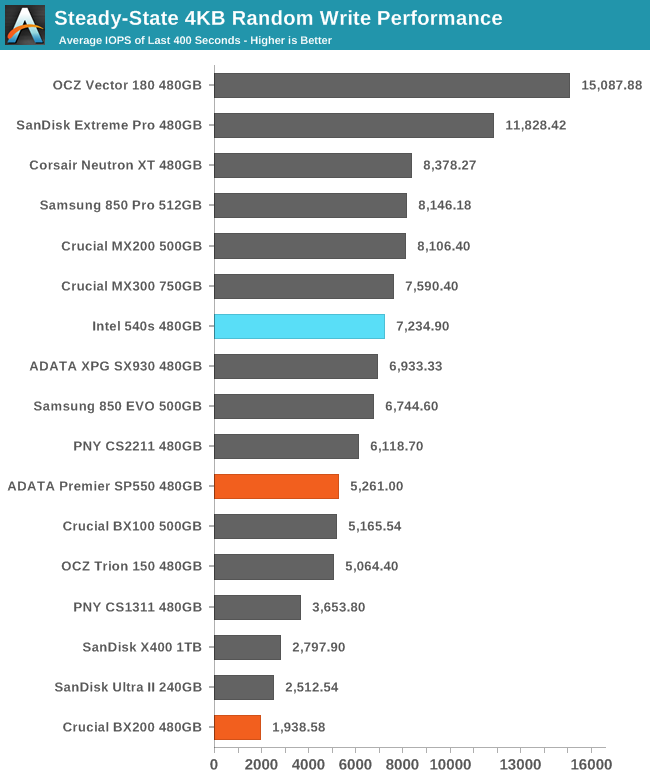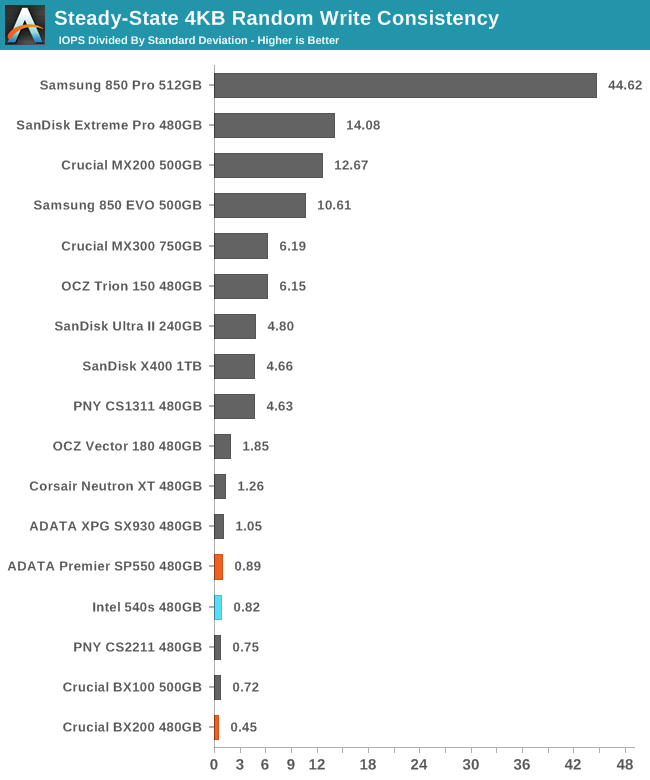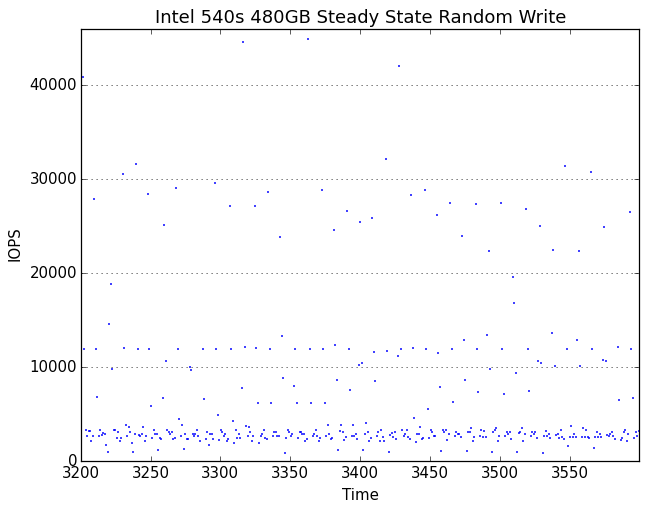The Intel SSD 540s (480GB) Review
by Billy Tallis on June 23, 2016 9:00 AM ESTPerformance Consistency
Our performance consistency test explores the extent to which a drive can reliably sustain performance during a long-duration random write test. Specifications for consumer drives typically list peak performance numbers only attainable in ideal conditions. The performance in a worst-case scenario can be drastically different as over the course of a long test drives can run out of spare area, have to start performing garbage collection, and sometimes even reach power or thermal limits.
In addition to an overall decline in performance, a long test can show patterns in how performance varies on shorter timescales. Some drives will exhibit very little variance in performance from second to second, while others will show massive drops in performance during each garbage collection cycle but otherwise maintain good performance, and others show constantly wide variance. If a drive periodically slows to hard drive levels of performance, it may feel slow to use even if its overall average performance is very high.
To maximally stress the drive's controller and force it to perform garbage collection and wear leveling, this test conducts 4kB random writes with a queue depth of 32. The drive is filled before the start of the test, and the test duration is one hour. Any spare area will be exhausted early in the test and by the end of the hour even the largest drives with the most overprovisioning will have reached a steady state. We use the last 400 seconds of the test to score the drive both on steady-state average writes per second and on its performance divided by the standard deviation.

Right from the start we see a substantial improvement of the SM2258 over SM2256, as steady-state random write speed has increased by 37%. This puts the Intel 540s well ahead of any other planar TLC drive and ahead of a few low-end MLC drives as well.

While the average random write speed has improved, the consistency is a bit worse and the Intel 540s scores in the bottom tier of drives. Phison's most recent generation of TLC drives managed to deliver very consistent steady state performance, but Silicon Motion still has a lot of room for improvement here.
 |
|||||||||
| Default | |||||||||
| 25% Over-Provisioning | |||||||||
The consistency of the 540s was clearly poor even before the transition to steady state, but during that early phase of the test it delivered twice the IOPS of the ADATA SP550.
 |
|||||||||
| Default | |||||||||
| 25% Over-Provisioning | |||||||||
Once in steady state, the 540s performance mostly stays slightly above the SP550. Both drives have frequent outliers beyond their band of usual performance, and the outliers are almost all in the direction of better performance. The Intel drive's outliers hit some much higher peaks than the ADATA SP550, suggesting that the new SM2258 controller may have significantly improved performance on bursty workloads.










77 Comments
View All Comments
Stuka87 - Thursday, June 23, 2016 - link
So disappointing. I bought up some Intel 740's because they were being discontinued. Glad I did now.prime2515103 - Thursday, June 23, 2016 - link
Did that BX200 really pull 45.69 watts in The Destroyer or is that a typo? How is that even possible?JoeMonco - Thursday, June 23, 2016 - link
The drive is broken garbage. That's how.Billy Tallis - Thursday, June 23, 2016 - link
That's Watt-hours. The Destroyer takes a typical SATA drive around 12 hours to run, so most drives are averaging a little over 1W.prime2515103 - Friday, June 24, 2016 - link
Oh I see... I'm going to have to read the testing methodology again, it's been awhile.cbjwthwm - Tuesday, June 28, 2016 - link
Did you do any re-testing of the drive with the firmware update 031C Intel released for it? It's too bad it can only be updated via ISO vs the Toolbox, and I found the ISO buggy (claimed it failed, but actually updated ok) which they have since pulled for "maintenance" ;)darkfalz - Friday, June 24, 2016 - link
Why does AT waste time reviewing a market segment where there is something like 5% noticeable difference across the board? And yet still haven't reviewed 10x0 series...vladx - Friday, June 24, 2016 - link
Guess the replacement for my Samsung 840 Evo is still going to be Sandisk X400. Intel's new SSD is a dissapointment.zodiacfml - Sunday, June 26, 2016 - link
Why? I guess, someone decided that the company should have a product at this price.fanofanand - Monday, June 27, 2016 - link
So Intel wants to charge the "Intel premium" while none of the components are Intel designed or made? Oh how the mighty have fallen. Between this drive, the $400 compute stick, and $1700 consumer CPUs, Intel is showing us just how out of touch they are with today's consumer markets.